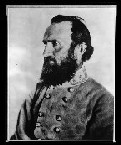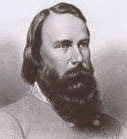 USA - McCook, McGinnis, McIntosh, McKean, MacKenzie, Mc... - 3/15/2007 9:07:26 AM
USA - McCook, McGinnis, McIntosh, McKean, MacKenzie, Mc... - 3/15/2007 9:07:26 AM
|
|
|
tdean001
Posts: 12
Joined: 3/4/2007
Status: offline

|
Brigadier General Robert Latimer McCook (b. 1827, d. 1862). Born in New Lisbon, Ohio, McCook began studying law and eventually opened a legal practice in Cincinnati. Originally a Democrat, McCook separated himself from the parties policies as war approached. Once the first shots of the Civil War were fired, McCook wasted no time in organizing the 9th Ohio Infantry regiment and was commissioned as a colonel. The regiment was composed primarily of recent German immigrants and was known as Die Neuner (the Ninth). They first saw action at the battle of Rich Mountain in West Virginia under General George McClellan. McClellan remarked that the Ninth was the best regiment he had ever seen, either in America or Europe. They often served as the vanguard for General McClellan's forces during this campaign. After fighting at Carnifex Ferry, also in West Virginia, they were transferred into the Army of the Ohio. During the battle of Mill Springs in January of 1862, McCook led his regiment in a successful bayonet charge upon Confederate positions. It was during this charge that McCook was severely wounded. During a brief furlough, McCook was promoted to brigadier general. He returned to active duty before his wounds had entirely healed, however, and this necessitated the use of a wagon for his transportation. Along with his escort, McCook was ambushed by partisans near Selma, Alabama. Six of the McCook brothers served the Union during the Civil War.
Leadership:
Tactics:
Initiative:
Command:
Cavalry:
Brigadier General George Francis McGinnis (b. 1826, d. 1910). McGinnis was educated in the public schools of Maine and then Ohio before entering the Mexican-American War as a private. He returned to military service with the 11th Indiana at the outset of the Civil War. He quickly advanced from a private to a lieutenant colonel within one month. McGinnis served as a colonel at the battle of Fort Donelson and was promoted yet again to brigadier general of volunteers on November 29th, 1862 in recognition of his performance at Shiloh. After serving in the Mississippi theater throughout the remainder of the war, McGinnis was mustered out on August 24th, 1865. His career after the war consisted of serving in numerous public offices, including the auditor of Marion county.
Leadership:
Tactics:
Initiative:
Command:
Cavalry:
Brigadier General John Baillie Mcintosh (b. 1829, d. 1888). Born in Tampa Bay, Florida to Lt. Col. James S. McIntosh, John lost his father at the age of 18, while he was fighting in the battle of Molino del Rey. John and his older brother James both entered military service, albeit through different pathways and on different sides during the Civil War. John first enlisted in the US Navy as a midshipman in 1848, before resigning in 1850. He was commissioned as a 2nd lieutenant of the US cavalry at the outset of the Civil War. McIntosh rapidly rose in rank and became 1st lieutenant and then colonel in 1862. He participated in many of the major battles in the Mid-Atlantic region, including Gettysburg, where his forces skirmished with Forrest's cavalry, and Chancellorsville. McIntosh performed with distinction and received numerous brevets and and other recognitions of his distinguished performance. During the battle of Opequon (Third Winchester), McIntosh had a leg amputated after being severely injured. Following the end of the Civil War, McIntosh retired from active service in 1870.
Leadership:
Tactics:
Initiative:
Command:
Cavalry:
Major General Thomas Jefferson McKean (b. 1810, d. 1870). McKean first enlisted in the US Army in 1831 and served garrison duty until 1834, when he resigned to pursue a career in civil engineering. He briefly served with the Pennsylvania Volunteers during the Seminole War before resigning yet again to resume working as an engineer. McKean was also an Iowa state constitutional delegate. During the Mexican War, McKean enlisted as a private and was severely wounded at the battle of Churubusco. More work in engineering awaited him after the Mexican War ended. He was named Paymaster of the US Volunteers on June 1st, 1861. McKean quickly tired of this and sought a command. He was rewarded with a promotion to brigadier general in November, 1861. McKean served in the Mississippi theater for the entirety of the war and was breveted major general just before being mustered out on August 24th, 1865. He retired as a farmer with a number of appointed government positions before passing away in 1870.
Leadership:
Tactics:
Initiative:
Command:
Cavalry:
Brigadier General Ranald Slidell MacKenzie (b. 1840, d. 1889). Regarding by General Grant as “the most promising young officer in the army”, MacKenzie led an amazing and tragic life. His father was a US Navy captain who, in 1842, had the son of the US Secretary of War hung for “mutinous” behavior aboard his ship. Ranald attended West Point, where he excelled in engineering. He graduated in 1862 and was commissioned into the engineer service of the IX Corps as a 2nd lieutenant. Ranald showed great promise and was promoted to 1st lieutenant and then captain in 1863. MacKenzie was promoted to colonel and served in the Army of the Shenandoah, where he was wounded at Cedar Creek. He then served with an engineer company in the Rapidan campaign and he was wounded (for the second time) at the siege of Petersburg. After the war ended, MacKenzie continued in the regular army and was a renowned Indian fighter. He led a punitive raid into Mexico after Indians attacked border towns in Texas in 1873. He also helped get revenge after Custer's massacre. In 1875, MacKenzie was thrown from a wagon and landed on his head. He remained dazed for several months. Afterwards, he was named commander of the Department of Texas in 1875. Upon his arrival, he was noted to be acting irrationally and was eventually committed to an asylum. He lived the rest of his days with his sister on Staten Island and died at the age of 48.
Leadership:
Tactics:
Initiative:
Command:
Cavalry:
Brigadier General Justus McKinstry (b. 1816, d. 1897). McKinstry was born in New York in 1816. His brother served as a California Supreme Court Justice. In 1834, McKinstry was appointed to West Point, where he graduated 40th in a class of 45 students. McKinstry first served garrison duty before serving in the Seminole War, Mexican War, and then on the frontier. He was named Chief quartermaster of the District of the West in 1861 and also promoted to brigadier general on September 2nd, 1861. His dealings as quartermaster were highly questionable and he was arrested and dismissed from duty on January 28th, 1863 for neglect and violation of duty. He was reported to have defrauded the Federal government of thousands of dollars. Not surprisingly, he later found employment as a stock broker and land speculator in Missouri.
Leadership:
Tactics:
Initiative:
Command:
Cavalry:
Brigadier General John McNeil (b. 1813, d. 1891). For a man who would come to be known as the “Butcher of Palmyra”, McNeil's first career was quite surprising. He was a hatter for over 20 years, first in Boston and then in St. Louis. Apparently, he was quite successful in the hatting business, because he also served in the Missouri state legislature and as the president of an insurance company. In May of 1861, he was named colonel of the 3rd Missouri Regiment and helped rout the Confederates at Fulton. His regiment mustered out in August 1861. McNeil was then commissioned colonel of the 2nd Missouri State Militia Cavalry in June, 1862. He also commanded the District of Northern Missouri during this time. It was during this time that he fought to cleanse the area of Confederate guerrillas. McNeil said that “where a Union man could not live in peace, a secessionist should not.” After retaking Palmyra from the retreating Porter, McNeil ordered the killing of ten Confederate prisoners as retribution for the kidnapping of Andrew Allsman, a Union loyalist and supposed informer. McNeil's actions were met with public outcry from both loyalists and secessionists, but McNeil defended his actions to the grave. He was promoted to brigadier general in November, 1862 and took command of the District of Southwest Missouri. He continued to serve in the command of various districts throughout Missouri for the duration of the war. He won renown for his defensive performance at Cape Girardeau, where he held his position with 1,700 men against a Confederate force of 10,000 men under General Marmaduke. McNeil was breveted major general on April 12th, 1865 and immediately resigned. After the war, he continued to serve as a politician. He was clerk of the criminal court in St. Louis county for three years and sheriff for four years. He was also the superintendent of the St. Louis branch of the United States post office. He died while at work in 1891 in St. Louis.
Leadership:
Tactics:
Initiative:
Command:
Cavalry:
Brigadier General Jasper Adalmorn Maltby (b. 1826, d. 1867).
Born in Ohio, Maltby learned the gunsmith trade before entering into the Mexican-American War as an infantryman. He was severely wounded at Chapultepec and mustered out in August, 1848. He then relocated to Galena, Illinois and opened a gunsmith business. He was very successful as a businessman. Once the War began, he joined the 45th Illinois Volunteer Infantry and was appointed Lt. Colonel. His unit fought at Fort Henry and Fort Donelson, where Maltby was again injured. Maltby was promoted to replace the previous commanding officer, who was promoted. The 45th performed so well under Maltby that they were chosen for the post of honor during the occupation of Vicksburg. He was promoted on August 4th, 1863 to brigadier general (making him the ninth general in the Union army from Galena). Maltby and his brigade remained in Vicksburg, serving as the city's garrison for the remainder of the war. He was mustered out in January, 1866. In 1867, he was appointed mayor of Vicksburg but died three months later from yellow fever. Maltby was well-renowned for his prowess as a gunsmith and Maltby's Plains Rifles are still recognized as some of the best rifles produced at the time. He is buried in Greenwood Cemetery, Galena, Illinois.
Leadership:
Tactics:
Initiative:
Command:
Cavalry:
And that's enough for right now. I'm still working on Alexnader McDowell McCook, James McQueen McIntosh, James Winning Macmillan, and Nathaniel Collins Mclean. But, I'm leaving for Guatemala tomorrow afternoon for ten days of medical work. So, no more biographies will come from me until my return.
Tom
|
|
|
|
 Printable Version
Printable Version








 New Messages
New Messages No New Messages
No New Messages Hot Topic w/ New Messages
Hot Topic w/ New Messages Hot Topic w/o New Messages
Hot Topic w/o New Messages Locked w/ New Messages
Locked w/ New Messages Locked w/o New Messages
Locked w/o New Messages Post New Thread
Post New Thread